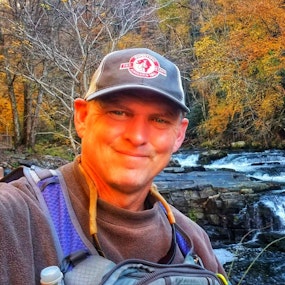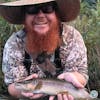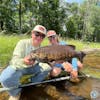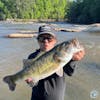S6, Ep 36: Mac Brown's Spring Hatch Hacks and Windy Day Tactics
Dive into the refreshing currents of early spring with host Marvin Cash and fly fishing virtuoso Mac Brown in the latest episode of The Articulate Fly. As the trees bud and the rivers swell, Mac shares his insights on the bustling hatch activity in Western North Carolina. With midday and evening waters teeming with life, he guides listeners through the prime time for dry fly and wet fly fishing, revealing the simplicity behind successful fly selection amidst the frenzy of the spring hatch.
Mac demystifies the overcomplicated world of fly choice, advocating for a straightforward approach that focuses on size, shape and color that's "even close." He shares anecdotes and experiments that underscore the opportunistic nature of Eastern trout, proving that sometimes, the right action trumps the perfect imitation.
As the conversation meanders like a mountain stream, Marvin and Mac discuss the importance of matching your fly's behavior to the natural movements of insects, especially in the gusty winds of spring. They suggest a handful of versatile patterns like the elk hair caddis, parachute Adams and the buoyant Humpy, which are all you need to cover your bases in the freestone rivers of their region.
Mac also highlights his upcoming casting school and invites anglers to join him for a transformative weekend of advanced line control techniques. As the episode draws to a close, the gentle reminder that the great outdoors is beckoning is coupled with the promise of tight lines and the thrill of the catch.
Whether you're a seasoned angler or looking to cast your first line, this episode is a treasure trove of wisdom that will help you navigate the vibrant waters of spring. So grab your rod, heed the call of the hatch and let the river's song lead you to your next great adventure.
All Things Social Media
Follow Mac on Facebook, Instagram and Twitter.
Follow us on Facebook, Instagram and Twitter.
Support the Show
Subscribe to the Podcast
Subscribe to the podcast in the podcatcher of your choice.
Speaker:
Marvin: Hey folks, it's Marvin Cash, the host of The Articulate Flower,
Speaker:
Marvin: back with another Casting Angles with Mack Brown. Mack, how are you?
Speaker:
Mac: I'm doing great. How are you doing, Marvin?
Speaker:
Marvin: As always, just trying to stay out of trouble. Was the Easter Bunny good to you?
Speaker:
Mac: Oh yeah, yeah, the Easter Bunny was good. Nice weather. And we turned back to
Speaker:
Mac: blackberry winter the last few days here.
Speaker:
Marvin: Yeah, but you were telling me that the spring hatch activity has been pretty good, right?
Speaker:
Mac: Oh yeah, yeah. Middle of the day has been really good. And start in the middle
Speaker:
Mac: of the day and towards the evening has been great with hatches and spinner falls
Speaker:
Mac: and four or five different things going on pretty much every day.
Speaker:
Marvin: And so what should folks expect to see kind of in those early spring hatches
Speaker:
Marvin: in western North Carolina?
Speaker:
Mac: Well, early in the morning, a lot of the trips you'll see start out there early
Speaker:
Mac: in the morning. So, I mean, it's going to be more of a nymphing game early.
Speaker:
Mac: And if they want to do more dry fly, then start midday.
Speaker:
Mac: Dry fly, wet fly is both really good.
Speaker:
Mac: Middle of the day. And wet fly can be, like, really good right up until dark.
Speaker:
Mac: And so the hatches are pretty easy to tell, I mean, just by looking up on the
Speaker:
Mac: surface. Once you start to see a lot of the risers and sippers everywhere,
Speaker:
Mac: then you know what's going on.
Speaker:
Mac: And what we look for always is looking for swallows. Like once you see all the
Speaker:
Mac: hundreds of swallows on the river, the bugs are already in the air.
Speaker:
Mac: And so that's always a surefire sign to switch over and move up, you know.
Speaker:
Mac: But it's tough. I like to start everything at midday.
Speaker:
Mac: People want to start early and get done early, you know. So a lot of times it
Speaker:
Mac: doesn't coincide with what the fish are going to do, you know?
Speaker:
Mac: Because I'd say the best dry fly activity on average the last couple of weeks
Speaker:
Mac: has been probably 1 o'clock to 3 o'clock in the afternoon.
Speaker:
Marvin: Yeah, that sounds about right. And we were talking before we started recording that,
Speaker:
Marvin: you know, even though you've got multiple species coming off and you've probably
Speaker:
Marvin: got a fair amount of size variation because usually those early mayflies are relatively large,
Speaker:
Marvin: but then you've also got the small little guys like the blue winged olives but
Speaker:
Marvin: you know we were talking about how people make fly selection you know too complicated.
Speaker:
Mac: That's right. I think they overthink it. And really, when you have a whole lot
Speaker:
Mac: of activity on top, like I'm talking like in a minute to have 40 or 50 rises
Speaker:
Mac: a minute in a little area that you're watching.
Speaker:
Mac: I don't think it matters when it's that kind of a frenzy, as long as the size,
Speaker:
Mac: shape and color is even close, like even close.
Speaker:
Mac: And I've done that a lot over the years just to prove a point,
Speaker:
Mac: like put something like an elk hair caddis and there is no caddis,
Speaker:
Mac: you know, and then that still works just as good as any other drop slot you'd pick.
Speaker:
Mac: So I think that's kind of overrated. I think what people forget in the East
Speaker:
Mac: Coast is it's very opportunistic fish in this part of the country.
Speaker:
Mac: I think it's that way all up to Alleghenies, all the way to Maine.
Speaker:
Mac: I don't think it's super selective anywhere that I've seen on the East Coast.
Speaker:
Mac: So I think a lot of those early hatch books that we read in the early 70s about
Speaker:
Mac: matching it exactly and all that, I think that's overrated, to be honest.
Speaker:
Mac: But I mean, as long as you have something on there that's floating on top,
Speaker:
Mac: then you could say, okay, you got a drift and nothing happened.
Speaker:
Mac: Let's say you did a dead drift, and then next thing you do is you animate the
Speaker:
Mac: fly, let it drift a second, animate it again, and all of a sudden you have a
Speaker:
Mac: fish. I think a lot of it's from the actions of what the angler's doing,
Speaker:
Mac: more so than the fly that they're picking.
Speaker:
Marvin: Yeah, and I would say, too, probably that lack of selectivity is a function
Speaker:
Marvin: of the fact that the reality is most of our rivers are freestones,
Speaker:
Marvin: and as a result, they're relatively sterile, right?
Speaker:
Marvin: So fish don't really want to let anything that looks like food pass them by
Speaker:
Marvin: because it's not the buffet that it is in some other places in the country.
Speaker:
Mac: That's right. Well, a good example, this was on Easter when the kids were small.
Speaker:
Mac: Connor's going to be 18 in a couple of weeks.
Speaker:
Mac: This is back when he was probably seven, so it was 11 years ago.
Speaker:
Mac: But I remember walking up there on Easter weekend with the family,
Speaker:
Mac: and I picked 10 dogwood leaves off of a bridge up high on Deep Creek.
Speaker:
Mac: And this was just a fun little experiment because I knew what would happen.
Speaker:
Mac: And so I had Jennifer and the kids looking off the bridge, and I rolled each
Speaker:
Mac: one of those little dogwood leaves up to about the size of a pea and would drop it in the river.
Speaker:
Mac: And eight of the ten dogwood leaves got eaten within three feet of drift.
Speaker:
Mac: So how picky are fish? And this is when there wasn't a hatch and the fish weren't coming up.
Speaker:
Mac: So if eight of ten leaves got eaten within three feet of drift and it wasn't
Speaker:
Mac: even prime time when they're looking up, feeding on the surface,
Speaker:
Mac: what's that tell us? Don't overthink your dry fly.
Speaker:
Mac: And I think that's why I wanted to talk about this for the podcast just because
Speaker:
Mac: I think people overthink it way more than they should.
Speaker:
Marvin: Yeah, which then gets us to pattern. And I would say probably in our part of
Speaker:
Marvin: the world, you know, orange and yellow elk hair caddis, probably a parachute Adams, right?
Speaker:
Marvin: And then maybe something that sits a little bit higher up, you know,
Speaker:
Marvin: not as flat in the water as a parachute style fly. I don't know,
Speaker:
Marvin: maybe a humpy or something like that.
Speaker:
Marvin: And, I mean, you pretty much got it covered. Yeah.
Speaker:
Mac: Yeah, I think pretty much that would do it. And it's like those flies will skate
Speaker:
Mac: well, like any traditional, like, Catskill-type flies are easy to skate and
Speaker:
Mac: ride high up in the water.
Speaker:
Mac: So if it's a windy day, having a fly that skates, because then it emulates the
Speaker:
Mac: insects, because insects get blown a lot.
Speaker:
Mac: So a good example, like a parachute sits flush down in the sun,
Speaker:
Mac: but they don't get blown naturally like the naturals that are getting blown.
Speaker:
Mac: You know what I mean? So a parachute's kind of tough to get blown on the surface.
Speaker:
Mac: And a lot of times, this sounds crazy, but we've had a lot of wind the last
Speaker:
Mac: week, like 20 to 30-mile-an-hour gusts, pretty constant here.
Speaker:
Mac: And when you look at the naturals, they're actually getting blown upstream really pretty quick.
Speaker:
Mac: And then when you put a fly out there and it's kind of just sitting in the current
Speaker:
Mac: or moving downstream when all the other naturals are going upstream,
Speaker:
Mac: just little things like that of changing styles of flies to match what the naturals
Speaker:
Mac: are doing. makes, I think, a lot of times a big difference.
Speaker:
Mac: That's something you don't hear about in those hatch books or anything.
Speaker:
Mac: But there's a reason why those flies that will skate and blow like the naturals
Speaker:
Mac: are a lot of times a better choice if it's windy.
Speaker:
Marvin: Yeah, it kind of reminds me of that talk that I gave in Edison in Denver about trout food and you.
Speaker:
Marvin: And it's like you don't have to remember all this stuff. If you just sit and
Speaker:
Marvin: look and see what the food's doing, make your fly look like the food and behave like the food.
Speaker:
Mac: That's right. Then it's going to be a much bigger ticket, I think,
Speaker:
Mac: to success by doing that.
Speaker:
Mac: And yeah, it's just the big thing right now is there's so many.
Speaker:
Mac: Spring's such a wonderful time. I made a post the other day about the hatches,
Speaker:
Mac: and some buddies in Ireland were texting me back and go, you know,
Speaker:
Mac: it's prime time over there too, this time of year.
Speaker:
Mac: And I think the thing is just to keep it simple and not overthink it.
Speaker:
Mac: You know, don't worry about having the perfect bug. If it's the same size,
Speaker:
Mac: shape, I mean, it doesn't even have to be the color.
Speaker:
Mac: Because if you animate a fly, they're probably not going to see the color.
Speaker:
Mac: I mean, if it's actually hopping and skittering and really moving erratic,
Speaker:
Mac: all they know is something's there.
Speaker:
Mac: And you're going to get what we call an impulse strike over something that's
Speaker:
Mac: selective where they can roll up.
Speaker:
Mac: And I'm sure people have dry-flied. They've seen that where the fish rolls up,
Speaker:
Mac: it's pecked sands, and it follows it two or three feet downstream looking at it.
Speaker:
Mac: And decides he doesn't want to eat it, you don't have to worry about those kind
Speaker:
Mac: of behaviors when you actually animate it.
Speaker:
Mac: You know, you're going after the one that wants to come and get it right then.
Speaker:
Mac: A little bit different strategy.
Speaker:
Marvin: Yeah, so we're kind of navigating this kind of shoulder season. It's kind of funny.
Speaker:
Marvin: I think we've had a 20-degree temperature drop here in Charlotte,
Speaker:
Marvin: and I know it's windy here. It's got to be howling where you are.
Speaker:
Marvin: But, you know, I know you've got schools coming up.
Speaker:
Marvin: You want to let folks know about those. And also, I know that you got people
Speaker:
Marvin: reaching out that want to get on the water.
Speaker:
Mac: Yeah, no, that'd be good. The big thing for this month coming up after the –
Speaker:
Mac: we've got a school that's coming up.
Speaker:
Mac: It's a casting two-day weekend school, April 27th, 28th, and we've still got
Speaker:
Mac: some room in that toward the end of April.
Speaker:
Mac: That's probably one of my favorite things of the whole year.
Speaker:
Mac: That one in September, we do a two-day weekend.
Speaker:
Mac: Advanced line control class here for fly casting, and that's always a lot of
Speaker:
Mac: fun. and then the trips, the same information's on the same site at mackgroundflyfish.com,
Speaker:
Mac: and they can find that info on there pretty easy.
Speaker:
Marvin: Well, there you go. Well, listen, folks, it's warming up.
Speaker:
Marvin: We're gonna have a nice week or so of weather, I think, once this front passes
Speaker:
Marvin: through, and you owe it to yourself to get out there and catch a few.
Speaker:
Marvin: Tight lines, everybody. Tight lines, Mack.
Speaker:
Mac: Tight lines, Marvin.

Mac Brown
Guide | Casting Instructor | Author
Mac Brown is the owner of Mac Brown Fly Fish and Fly Fishing Guide School in Western NC. Mac created the first full-time fly fishing guide service in Western North Carolina. The first Delayed Harvest on the Upper Nantahala River in early 1993 was also a result of his efforts.
Mac Brown is the author of “Casting Angles” which is a fly casting handbook for those on the journey of understanding the mechanics of the cast. The ACA, FFI, and others have endorsed this text as a reference for instructors as well. Mac is a Master Casting Instructor through the Fly Fishers International.










